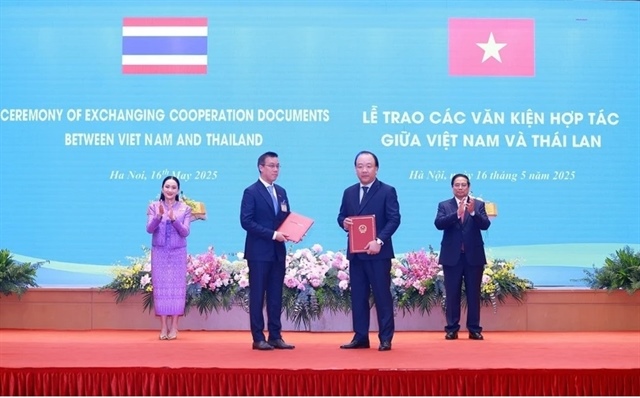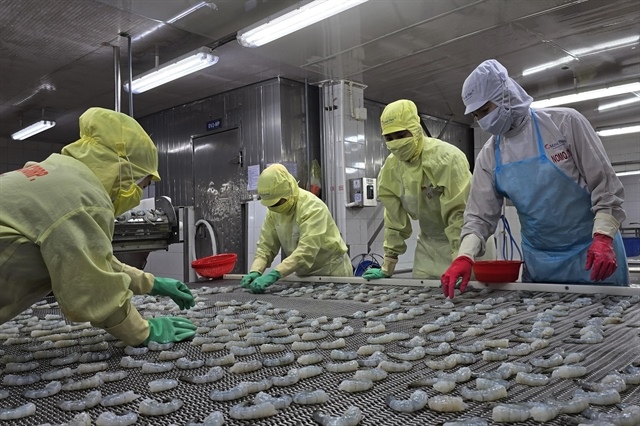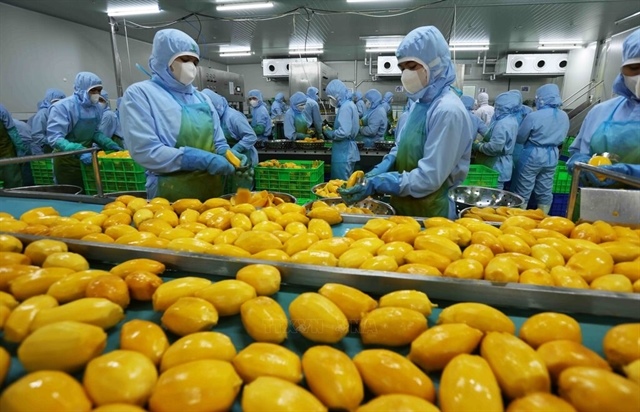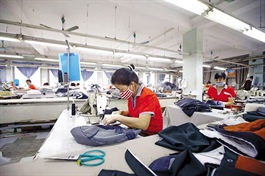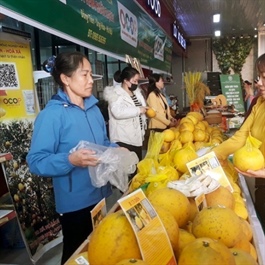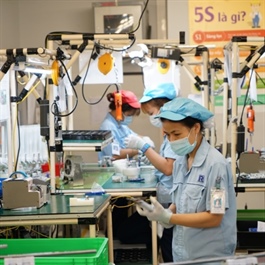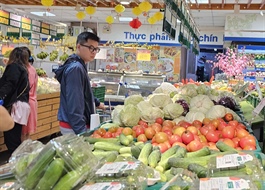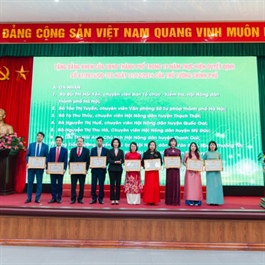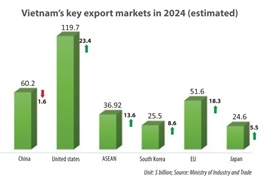Vietnam’s 2025 retail sales projected to hit $350bn
Vietnam’s 2025 retail sales projected to hit $350bn
The Vietnamese Ministry of Industry and Trade forecast the local retail sales at US$350 billion this year, contributing 59 percent of the domestic goods sales.
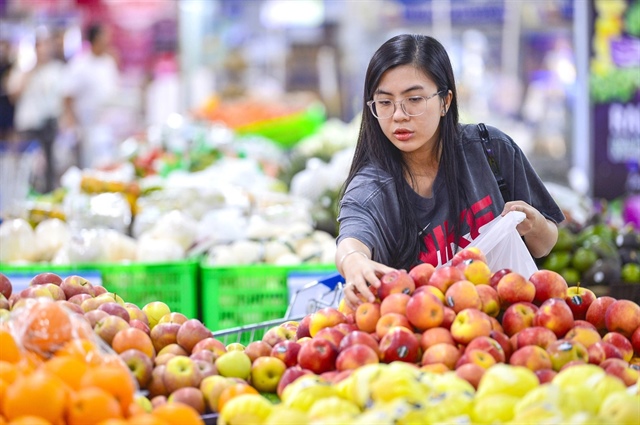
A consumer shops at MM Mega Market in Thu Duc City, a district-level administration unit under Ho Chi Minh City. Photo: Quang Dinh / Tuoi Tre |
The retail sales in 2024 rose 8.8 percent over 2023, according to the General Statistics Office.
Vietnam needs many breakthrough solutions to maintain the attractiveness of its retail sector, experts said.
Foreign cosmetics brands report growth
The Body Shop, a British cosmetics brand that is popular in Vietnam, especially among the young, filed for bankruptcy in the U.S. and Canada, closing 50 and 33 stores in the two countries, respectively, in March 2024.
Meanwhile, its operations in Vietnam remained unaffected and even expanded in major cities.
The brand currently has 41 retail outlets in Vietnam.
Many enterprises have suffered the aftermath of the COVID-19 pandemic and economic fluctuations over the past few years, but The Body Shop has boosted its online retail, especially through social media, in Vietnam.
After the COVID-19 pandemic, The Body Shop Vietnam has achieved an annual revenue growth rate of over 20 percent, while its parent company’s consolidated revenue has declined.
Nguyen Thi Xuan, an employee of a The Body Shop store on Mac Thi Buoi Street in District 1, Ho Chi Minh City, said she had been working at the store for nearly seven years. Despite difficulties, customers have increasingly bought products at the store.
A representative from cosmetics group L'Oreal in Vietnam told Tuoi Tre (Youth) newspaper that its retail revenue in Vietnam grew 17 percent in 2024.
The retail market in Vietnam is competitive, especially amid the growth of e-commerce, the representative added.
The firm has built sales channels on various platforms, offered diverse products and increased promotion programs with an aim to increase the growth rate to 20-25 percent this year.
Purchasing power rising
Besides cosmetics, the retail sales of food, beverages, and processed products have also increased.
GC Food, a leading Vietnamese exporter of aloe vera products to 20 countries and territories, such as Japan, South Korea, Europe, the Middle East and Southeast Asia, with a volume of 15,000-17,000 metric tons per year, earned nearly VND720 billion (US$28.3 million) in net revenue and nearly VND100 billion ($3.9 million) in after-tax profit last year.
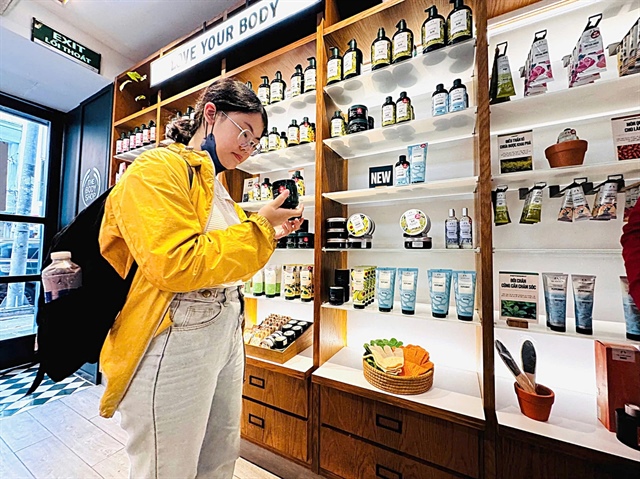 |
| A young woman has a look at a The Body Shop store in District 1, Ho Chi Minh City. Photo: Thanh Hiep / Tuoi Tre |
GC Food chairman Nguyen Van Thu said the result was thanks to the retail sales in the domestic market.
The retail sales of processed aloe vera and coconut jelly products surged 60 percent last year, Thu informed.
Changing strategies to boost retail sales
Many store chains scaling up their business, foreign investment rising, and e-commerce booming after the COVID-19 pandemic have fostered the retail industry in Vietnam.
However, the competition from foreign direct investment (FDI) companies also poses a challenge, requiring domestic retail companies to make significant efforts.
Thu predicted that economic growth would slow further in 2025, with reduced global demand. Enterprises, including retailers, need to adjust their strategies to adapt to current trends.
According to Le Trung Nam, director of EPS Investing Vietnam, Vietnam's population is predominantly young, with Gen Z being the primary consumer group.
Even in the face of economic difficulties or saving trends, this generation maintains its spending habits, boosting the retail sector.
Another reason contributing to the growth of Vietnam's retail sector is China's retail stimulus policies as Chinese goods meet the demands of the Vietnamese market.
To further develop Vietnam's retail sector, Nam emphasized the importance of supporting investors and creating a transparent and open business environment.
Catering to the needs of young consumers is essential. In this data-driven and AI-powered era, enterprises should rely on data analytics to make decisions, Nam recommended.
Dr. Nguyen Huu Huan, head of the Financial Markets Department at the University of Economics Ho Chi Minh City, said three pillars of Vietnam's economy are export, public investment, and domestic consumption.
Huan assessed the potential of Vietnam's retail market as immense, explaining that Vietnam is among the Southeast Asian countries with the fastest-growing middle-class population.
The proportion of this class in the total population is projected to increase to 26 percent by 2026. When people's incomes rise, their demands for healthcare, beauty products, and luxury goods will also increase.
To boost Vietnam's retail sector, Huan proposed rolling out “red carpets” for domestic enterprises and mandating FDI firms to partner with domestic companies in joint ventures to operate in the domestic market.
Vietnam does not have many incentives for domestic startups and small and medium enterprises.
Meanwhile, the country has offered many preferential policies for foreign firms, such as 50-year land rent exemptions and value-added tax reductions.
As a result, Vietnamese enterprises also need support to avoid being overshadowed, Huan added.
Shortage of large e-commerce retailers
Foreign retailers have rushed to channel capital into the Vietnamese market, putting heavy pressure on domestic enterprises.
FDI enterprises boasts global supply chains, strong competitiveness, and large-scale operations, while domestic firms are increasingly being overshadowed in their home market due to high costs and weak competitiveness.
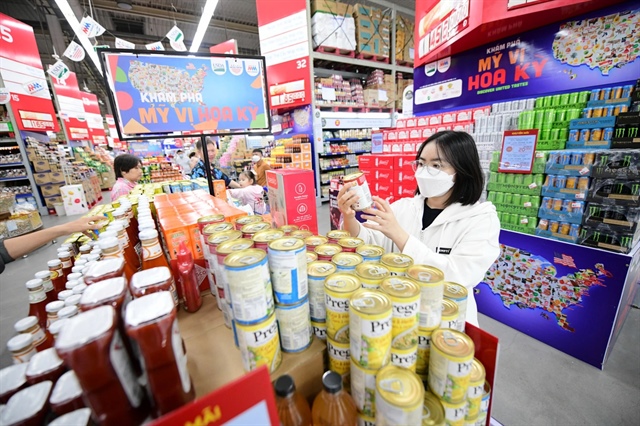 |
| Consumers choose products at MM Mega Market in Thu Duc City, a district-level administration unit under Ho Chi Minh City. Photo: Quang Dinh / Tuoi Tre |
Phan Dinh Quan, director of EZ Shipping Co. Ltd. in Hanoi, claimed that the domestic retail market lacks large retailers, especially in the e-commerce sector.
Logistics costs account for a large portion of retailers’ total expenses, ranging from 10 to 20 percent. Domestic retailers need to have a deep understanding of the market, their retail models and customers.
Quan advised local retailers to build various sale channels and focus on product trial, return and exchange, as well as convenient and quick payment.
According to the General Statistics Office, Vietnam’s wholesale and retail sector attracted nearly $1.37 billion in FDI as of November 2024, ranking third among all sectors.
The sector took the lead in terms of the numbers of new projects and share acquisitions, accounting for 35.3 and 42.4 percent, respectively.
The growth demonstrates that Vietnam’s retail market is attractive to foreign investors.
Many conglomerates from Japan, Thailand, South Korea, and Singapore have expanded to the Vietnamese market.
According to the International Monetary Fund, the Vietnamese F&B market is projected to reach VND655 trillion ($25.8 billion) in the next five years, positioning Vietnam as one of the countries with the most significant growth potential in the global F&B sector.
As a result, many global enterprises are actively seeking opportunities to venture into the Vietnamese retail market.




